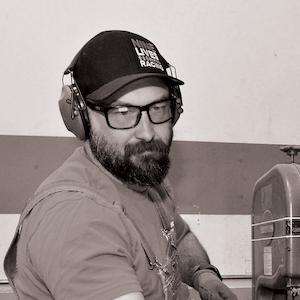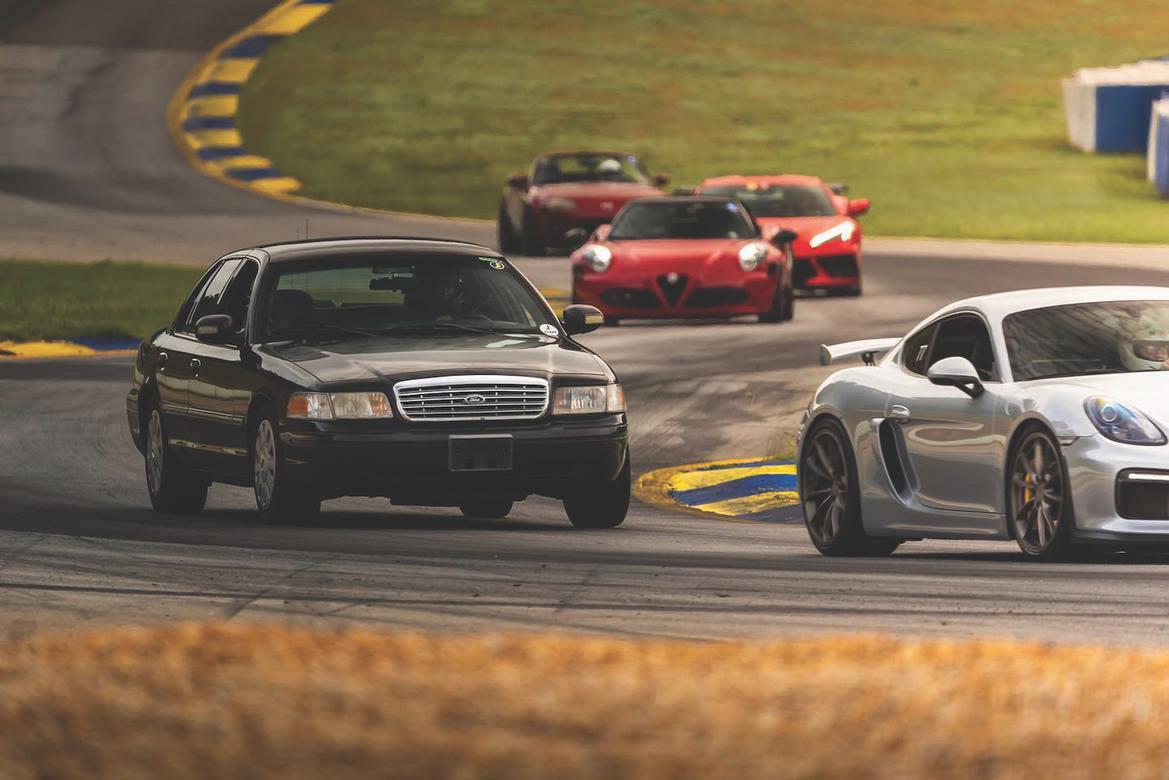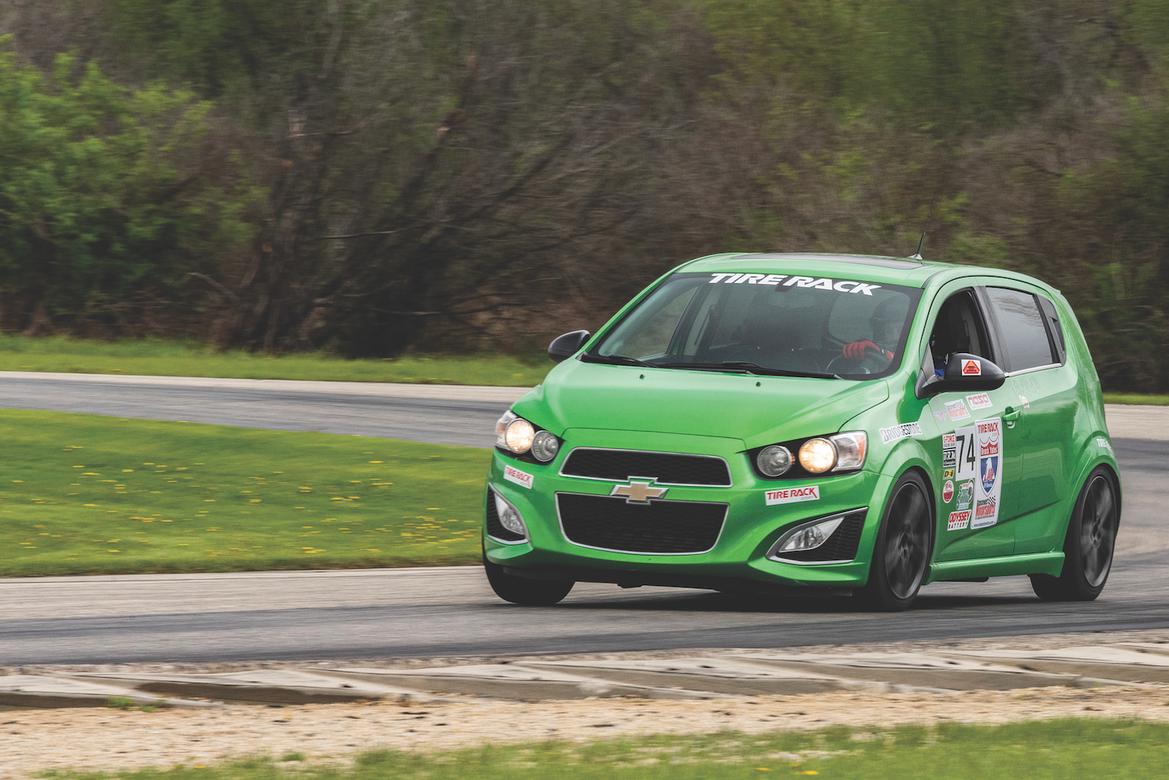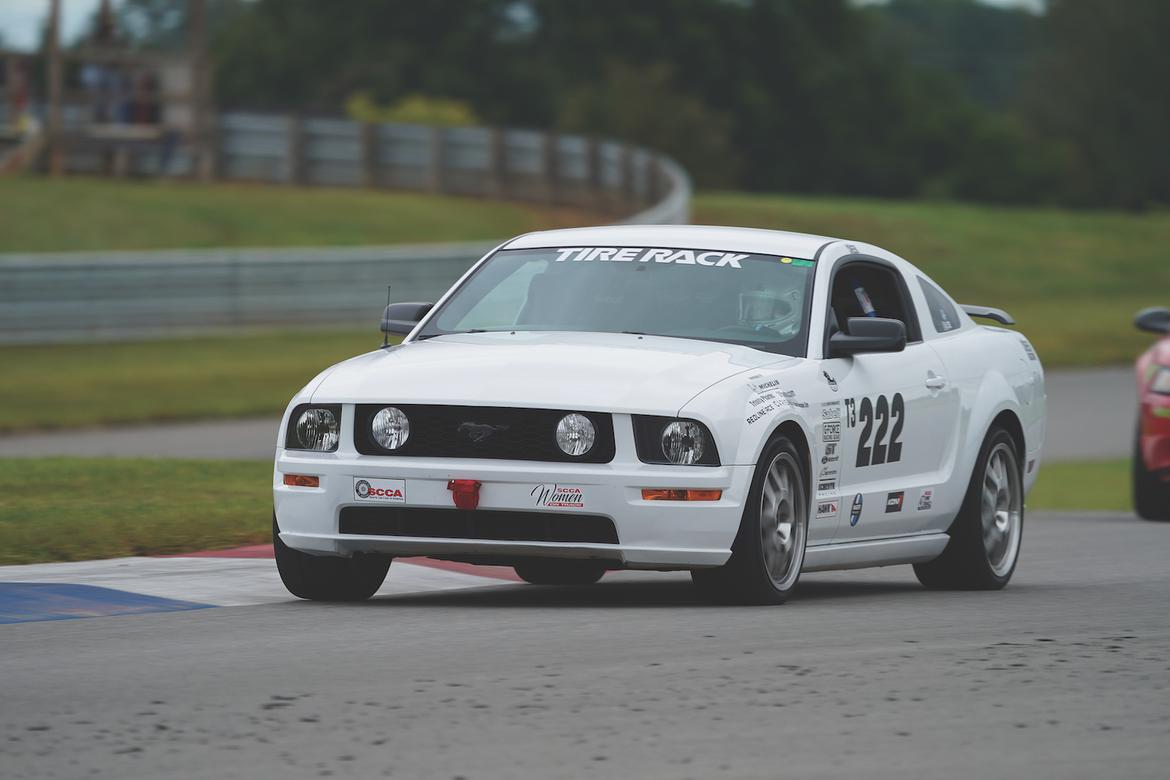Good question. One look at any grid shows that the answers are as varied as the people doing the driving.
The ideal track car could be a turnkey offering, a homebuilt special or just an unassuming sedan. It could be box-stock or incredibly complicated.
Ray Evernham: NASCAR legend

“When I think about a ‘track car,’ I think about what I want to drive and what I want my experience to be like,” explains Ray Evernham, vintage racer, Pikes Peak class winner, founder of the SRX race series, former NASCAR team owner and crew chief for three of Jeff Gordon’s NASCAR championships.
“The most satisfying part is when you don’t have to worry about rules and can just build something that makes you feel a certain way, aside from performance alone,” he continues.
When Ray set about building his Ghost, a thoroughly modern track car that can lap Daytona within a few seconds of a GT3 machine yet resembles a 1936 Chevy, he started with that mindset: “Asking someone what makes the perfect track car is so subjective, like asking them what color you want to paint your house or what music is best. There’s no correct answer, just how you want to feel driving it and being around it.
“I wanted a car that looked like the stuff I grew up watching, which was the old Modified cars. So we took that as an overall theme but applied modern technology.”

After a star-studded motorsports career, Ray Evernham set out to build the Ghost, his ultimate track car. Photography Credits: Chuck Andersen, Dave Green (headshot)
Tires are also a huge factor when building a car, he continues. “Whenever we start a new project, we practically build it around a certain tire. With the Ghost, we used the 16-inch Goodyear GT1/Trans-Am tire since we knew what it was capable of on a car with similar weight and power levels.
“But even someone who is building something at a casual level has to look at their tire choice and ask if they’re appropriate for the venue, for the application, and what the availability is like,” he continues. “It’s no good building a car around a tire you can’t get anymore.”
Ray also preaches the ladder method: “If you start with a platform that can easily be progressively upgraded in terms of power, tire size and downforce, that to me is the ideal platform–something that can grow as your skills and desires grow with it.”
He also recommends sampling some different flavors before committing to any one formula. “Go drive an open-wheel car or some purpose-built race car, and go drive a big sedan,” he says. “One will teach you about what a car can do when everything is ideal, and the other will show you what happens when the driver has to manage more of the car and the tire. Some people really end up preferring one type over the other.”
John Hunter: SCCA Time Trials program manager

“I think there’s a combination of factors in play for me,” John Hunter says. “Balance is key. It has to dive in a way I enjoy on track, first of all.”
And he adds some more attributes: “It also helps if it’s something common and affordable. It may not be sexy, but having a car that’s easy and cheap to fix and upgrade is a big plus.”
John even offered a couple of real-world examples for those shopping today. “I’m a rear-wheel-drive guy,” he continues, “so I think the E36 BMW 3 Series is a pretty ideal compromise. There’s lots of engine options, they’re plentiful, and it’s also a car that can grow and be modified as your skills and desire for speed increase.”

For those venturing into their first track days, the SCCA’s John Hunter recommends something common, like a BMW 3 Series. Photography Credits: Perry Bennett
Indeed, if you look at the results from a few SCCA National Time Trials events, you’ll see E36s of various prep levels competing on even footing in divisions ranging from near-stock to full-race.
John also likes the utility of the model’s form factor. “It’s a four-door, or a two-door sedan, so you have some room for stuff if it’s your only car,” he explains. “I’m a Miata guy at the moment, and I realize it’s always ‘the answer,’ but it’s not a great answer to carry anything more than a small bit of luggage.
“The other thing a large, square car gives you is room for safety gear without compromising too much interior space. In an E36, you can add a roll bar and there’s still room to put stuff in the back seat–and you hardly notice from the front seat.”
One more car for his short list: “I guess a Honda Civic would be the front-wheel-drive equivalent if you were into that, but every time I think of Civics, I keep thinking how much fun a K-series-powered E36 would be instead.”
Johnny Cichowski: Nine Lives Racing founder

For some, a track car is an opportunity to push the limit–both on and off the track. It’s a vehicle for improving as a driver, a builder and a problem solver.
“So I like cars that are 1) a project and 2) terrifying,” explains Johnny Cichowski, builder of what can best be called a V8-powered, Miata-shaped object that also serves as a test bed for Nine Lives Racing’s aero devices.

Photography Credits: Kevin Adolf, Chris Tropea (headshot)
Racing/” target=”_blank”>[Shop Visit: Nine Lives Racing]
“And then I like a car that you need to pay attention to all the time,” he continues, “that’s just such a handful that getting the most of it is almost impossible.”
But there’s a constant constraint: “Thirdly, the budget is always kept in mind. We dumpster dive, but we know where all the good dumpsters are.”
Another advantage of a build not limited by the rule book: “Whenever I got a crazy idea, it’s there for me to mess with it.”
Robb Holland: Pro racer

Robb Holland spends his weekends competing in professional road Racing series like the SRO World Challenge, so we figured he would have some strong opinions about what constitutes an ideal track car. And we weren’t wrong. But we were also impressed by how accessible some of his picks were.
[Robb Holland Helps You Tackle the World’s Greatest Race Tracks—Both Virtual and Real]
“The perfect track car to me is one that’s challenging enough that it makes you work a bit to get pace out of it,” Robb says, “but not so challenging that you’re worried it’s going to bite you on every corner.”
He even provides a common example: “That pretty much describes any Porsche 911 made in the last decade and a half.”
But Robb also qualifies this pick a bit: “Modern sports cars are so fast and so capable that going anywhere near the limit where you start to challenge them means you’re moving at insane speeds. So there’s a lot to be said for cars like the Toyota 86 and Porsche Cayman, where you can drive them at or near 100%, but their 100% isn’t warp speed.”

Not up for tracking the latest supercar? Pro racer Robb Holland suggests a machine that’s still challenging, like a Subaru BRZ. Photography Credits: Perry Bennett, Rupert Berrington (headshot)
[Could the 86 Coupes Replace the Miata as the Answer?]
It’s probably no mystery, then, that Robb’s current track weapon of choice is a Porsche Cayman GT4 RS in the Pirelli GT4 America series. He does pilot it at or near warp speed.
Gino Manley: Track day addict, sometime IMSA racer

Gino Manley spends a lot of time on track. He recently ran 53 consecutive weekends, from club-level events in a decommissioned police car–complete with lights and siren–to NASA’s 25 Hours of Thunderhill to fielding an Audi TCR racer at IMSA’s Daytona weekend.
[Running in an IMSA race on a grassroots budget]
“Over the years, I’ve gone back and forth on that answer,” he replies when asked to describe the ideal track car. “Once it was about being fun to drive, then what would be the fastest. Then, as I got more experienced, maybe lowest cost to run could be the definition of perfect.”
But, he says, he finally has it figured out. “Having driven just about everything over the past couple of years, my answer has matured to this: The perfect track car is whatever you have access to right now.

Photography Credits: Jonathan Hargrave, Courtesy Gino Manley (headshot)
“There will forever be a better machine than the one you have now, whether it’s a $1500 Craigslist special or a $250,000 factory GT4 car. But some of the greatest ‘track’ cars ever made will never see more than the cars and coffee parking lot, while some idiot will take his old police car out onto the track–which, by definition, would make it a track car.”
Brock Yates: One Lap of America coordinator

“I am a firm believer that slower is better than faster,” says Brock Yates, “because everyone goes out and buys a track car and gets a GT350, and then some poor bastard sits right-seat while you learn how to drive it.
“And you never drive it 10/10ths,” he reasons. “You can have a lot more fun at 10/10ths in a shitty car than less than 10/10ths in a fast car.”

While One Lap attracts the latest supercars, event organizer Brock Yates sees the appeal of wailing on something slow and simple. Photography Credits: Highland Design Studio
His personal track machine falls into that slower-but-better category: a 1985 Shelby Charger. The front-drive Dodge is, he says, “somewhat modified.”
The next most fun car Brock has tracked, he continues, was a Bugeye Subaru that, he admits, was on suboptimal brakes and old, all-season tires. “And know something?” he continues. “I had a shitload of fun. You couldn’t go fast enough to hurt the car. I slogged that car at 9/10ths or 11/10ths without guilt, without fear.
“You’re there to learn how to be a better driver,” he stresses. “A car you can learn in and afford to lose–and you can drive at the limit–is the best car for you.”
Ryan Cheek: SCCA Time Trials admin assistant

“The ideal track car has to be affordable for the driver,” says Ryan Cheek, leaning directly into the pragmatic realities of track-based car enthusiasm. Indeed, being a part of track culture extends well beyond the actual track driving experience, and receipts can pile up quickly.
“You need to not only be able to own the car,” she explains, “but to afford the cost of maintenance, whether you’re turning your own wrenches or having the work performed by someone else.”

Photography Credits: Perry Bennett
Not content with bumming us out with that harsh dose of reality, Ryan, who runs her SN95 Mustang at hillclimb and time trial events, adds, “There should be enough funds after actual car expenses for track day entries, fuel expenditures to/from/track driving and also money for lodging and food.”
And while this all seems a bit like a Dave Ramsey dressing down, she’s entirely right. Many folks have gotten burned out of track life because they didn’t properly budget or failed to enter the sport with their eyes fully open to the logistical and fiscal realities of the hobby. So while the financial factors are certainly not part of the romantic ideal of living life between the apexes, you must face them to negotiate the hobby successfully.
But Ryan also has some thoughts about the driving experience. “The car has to put a smile on the driver’s face when they are behind the wheel,” she says. “It’s very simple. If the driver is not having fun behind the wheel, that is not the ideal track car.”
#track #car #experts


![‘Graveyard Shark’ – Practical Suit Creature Feature Looks Like ‘Street Sharks: The Horror Movie’ [Trailer]](https://freegames.schoolpk.org/wp-content/uploads/2024/05/‘Graveyard-Shark-–-Practical-Suit-Creature-Feature-Looks-Like-‘Street-300x180.png)

More Stories
Leclerc: Ferrari response “coming very soon” with upgrades
Sainz loses fourth place after penalty for Piastri collision
Miami F1 win a weight off McLaren’s shoulders, not just Norris’s – Stella